Where are the best places to see Art Nouveau architecture in Paris?
On my last trip to Paris, I got a chance to explore some of the best examples of Art Nouveau architecture in the city.
Paris has a great collection of flamboyant and whimsical Art Nouveau buildings.
These Art Nouveau buildings are quite unique in the general landscape of Parisian architecture.
In this guide you’ll find:
- The history of Art Nouveau architecture in Paris
- The most famous Art Nouveau buildings in Paris
- The most celebrated Art Nouveau architects
- Two easy self-guided walks in the districts of Paris where you can see plenty of Art Nouveau gems. Get a map of the self-guided walks.
A brief history of 19th-century parisian architecture
As you walk around Paris you will notice that most buildings are designed in a uniform style, also known as the Haussmannian style.
Georges-Eugène Haussmann was the urban planner who, back in the 19th century, redesigned the city of Paris and is very much responsible for the way many parts of the city look to this day.
Paris used to have narrow streets with little light or air. Haussmann’s vision for the city was of wide streets and boulevards, parks, squares and large and elegant modern buildings.
The beige stone facades with wrought iron balconies and chimneys on every rooftop you can see all around in Paris are the trademarks of the Haussmannian style.
Strict regulations were put in place to ensure the uniformity of these exteriors.
However, around 1880 there was a need for change, and the local government encouraged that change through competition for the most beautiful facade and by relaxing the uniformity rules.
That was when new designs started to appear. Thischange coincided with the emergence of Art Nouveau in Europe, and architects experienced a burst of creativity, resulting in hundreds of buildings in the Art Nouveau style.
The two most notable Art Nouveau architects in Paris were Hector Guimard and Jules Lavirotte. Many of the city’s best Art Nouveau examples carry their signatures.
What is Art Nouveau architecture?
At the turn of the 20th century, the movement known as Art Nouveau was born in various places in Europe and soon spread across the ocean as well.
The most typical elements of the Art Nouveau style are fluid, whiplash curves, creative ironwork and elaborate decorations inspired by nature.
Some Art Nouveau buildings also feature stucco decorations, stained glass windows and intentional asymmetry.
Here’s a great video about the history of Art Nouveau:
Famous art nouveau buildings in paris
Before we start our self-guided walks, here are some of the most famous Art Nouveau buildings in Paris worth seeing while you’re visiting the city.
Galeries lafayette haussmann
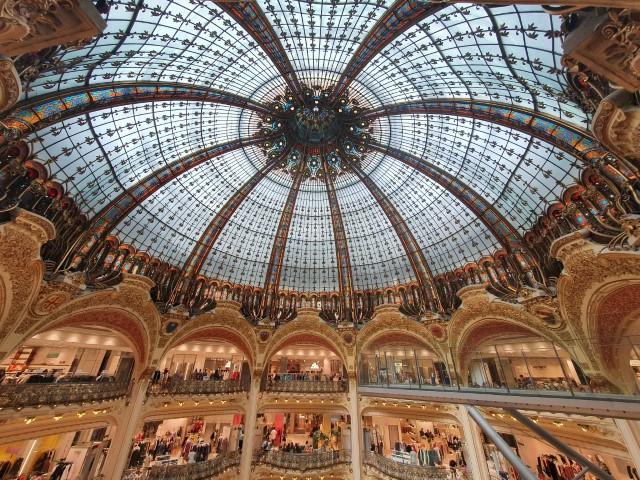
This upmarket department store has the most magnificent dome.
Walk inside the Coupole building of Galeries Lafayette Haussmann to see it in the great hall and climb up to the upper floors for even more stunning views.
This ceiling dates back to 1912. It was designed and decorated in the Art Nouveau style of that era by Édouard Schenck, Jacques Grüber and Louis Majorelle.
It is worth a visit, even if you’re not planning to go shopping. It’s also right next to the opera house (Palais Garnier), which I also recommend you visit while you’re in Paris.
Address: 40 Bd Haussmann, 75009 Paris
La samaritaine
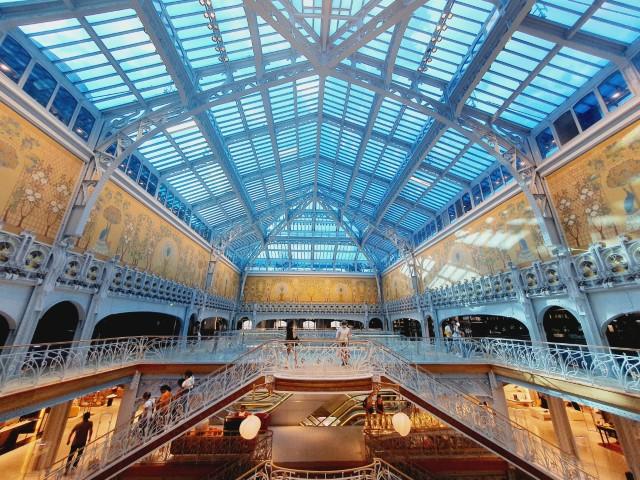
Another very impressive department store in Paris that’s worth a visit is La Samaritaine.
The magical glass roof, the gorgeous staircase and the delightful wall painting on the top floor, all make it a true architectural gem.
You want to climb up to the 5th floor for the best view. When I took the elevator going up, everyone else in the elevator was holding a camera too…
La Samaritaine was designed by architect Frantz Jourdain and is listed as a historical monument.
It is in a very central location, by the Seine river, close to Pont Neuf and Rue de Rivoli.
Address: 9 rue de la Monnaie 75001 Paris
Hotel elysees ceramic

The Ceramic Hotel close to the Arc de Triomphe is another unique Art Nouveau building in Paris.
This is a building by architect Jules Lavirotte from 1904 and it features the typical Art Nouveau characteristics we’ll see in the self-guided tours below.
It also features a pretty extraordinary use of ceramics throughout the facade, which gave the building its name.
Address: 34 Avenue de Wagram, Paris
Self-guided walks of art nouveau architecture in paris
Below are two short self-guided tours exploring Art Nouveau in Paris.
If you prefer a guided tour, this tour covers more locations with a professional guide.
These self-guided walks take you to two of the main hubs of Art Nouveau in Paris.
The buildings in each of these are all within walking distance of each other.
You can easily take both walks on the same day. The first part is in the 7th arrondissement (not far from the Eiffel Tower) and the second part is in the 16th arrondissement.
Lavirotte building – paris art nouveau gem and nearby buildings
The 7th arrondissement has some wonderful Parisian Art Nouveau architecture.
Lavirotte building (immeuble lavirotte)

The Lavirotte Building on 29 Av. Rapp is a richly decorated house and is a prime example of Art Nouveau architecture in Paris.
It’s asymmetrical, like many Art Nouveau buildings, and has faces, flowers, animals and various shapes creatively decorating its magnificent facade.
I took my time examining this facade and taking as many pictures as I could. While I was there at least 5 or 6 other people came by to do the same.
Art nouveau on rue sedillot
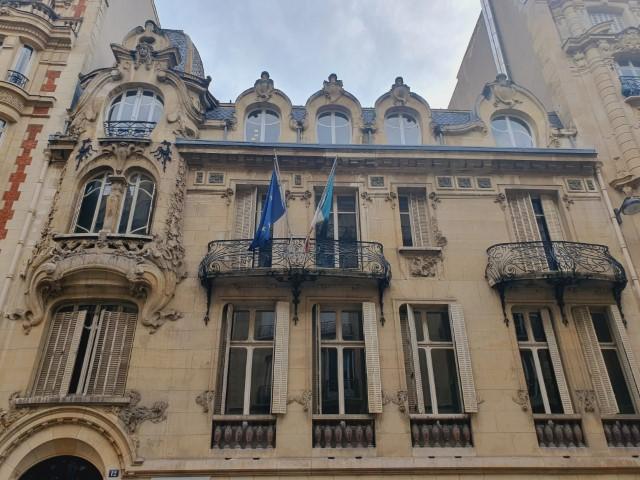
Sedillot street is a very short walk from Lavirotte Building. The entire street is full of beautiful buildings, but the one at number 12 Rue Sedillot stands out.
It is another building designed by Lavirotte, built in 1899. Today it is home to an Italian college called Leonardo Da Vinci.
It has all the trademark Art Nouveau characteristics that make it a great work of art: You’ll notice the asymmetrical design, the elegant curves and the use of iron railings. The decorations around the windows are especially exuberant.
Art nouveau on rue de grenelle
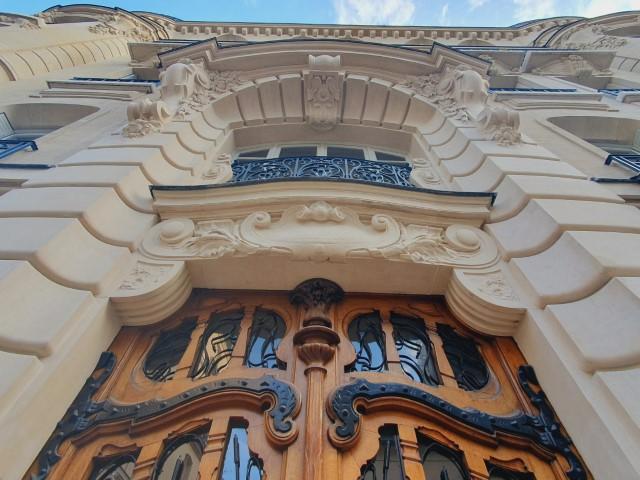
A short walk from Rue Sedillot is another Art Nouveau building worth exploring.
When you reach 151 Rue de Grenelle, you’ll see a beautifully elegant facade from 1898.
This house is slightly more modest compared to the other two we’ve seen so far. That’s probably because it was the first building by Lavirotte in Paris. However, his style became more elaborate fairly soon after that.
Art Nouveau is often described as whimsical and if you walk up to the wooden and wrought iron front door of this building, you’ll see it is decorated with two lizards on the door handles.
La maison des arums
The next stop on this part of the tour is at 33 Rue du Champ de Mars.
Architect Octave Raquin designed this gorgeous building in or around the year 1900.
Thanks to its elaborate carved stone floral decorations, it has been nicknamed the House of Lilies (La Maison des Arums)
Take your time appreciating all the graceful details of this facade.
Paris art nouveau architecture walk around rue jean de la fontaine
The second part of this Paris Art Nouveau tour takes place in the 16th arrondissement.
To reach the first stop, you can use public transport (planner) or walk for about 30 minutes from 33 Rue du Champ de Mars to 14 Rue Jean de la Fontaine.
Castel béranger
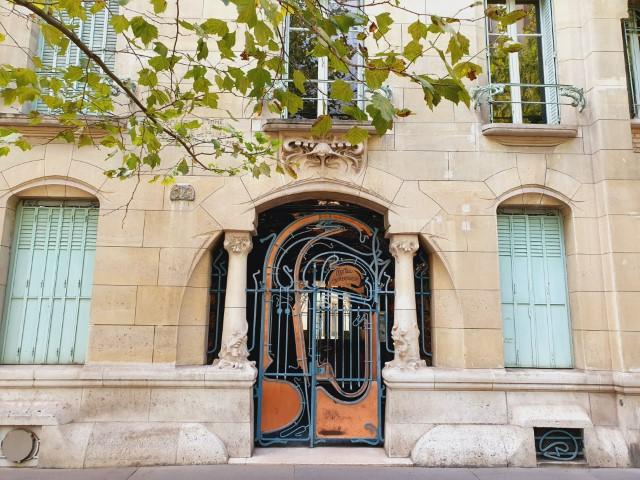
The first stop in this part of the tour is an iconic Parisian Art Nouveau building called Castel Béranger, on 14 Rue Jean de la Fontaine.
This is a creation by Hector Guimard, the architect also famous for designing the classic Paris metro station.
Completed in 1898, this building won a competition for the most beautiful facade in Paris and is now classified as a Historical Monument in France.
The Castel Béranger is probably its most prominent feature, but the entire facade has plenty of ornaments and details to observe.
Rue agar and café antoine

As you continue along you’ll reach Café Antoine on the corner of Rue Agar.
Rue Agar has a beautiful residential complex designed by architect Hector Guimard.
In 1911 it was named “Modern Street”, as the Art Nouveau design represented the spirit of the time.
You’ll notice some of the typical Art Nouveau features, like the iron balconies, the use of curves and elegantly decorated doors and windows all along this little street.
Café Antoine on the street corner is another authentic Art Nouveau gem designed by Guimard.
Immeuble trémois

Continue walking on rue Jean de la Fontaine till you reach Rue François Millet.
There at number 11, you’ll find the lovely curved facade of the Trémois building, another Art Nouveau residential house by Guimard.
Hôtel mezzara

Our next stop is another Guimard creation, at 60 Rue Jean de la Fontaine. You will easily recognise the Guimard style we saw on the previous stops on this tour.
Hôtel Mezzara dates back to 1910-1911 and was originally built as a family home for French textile industrialist Paul Mezzara.
The interior is also very beautiful, but unfortunately, it was closed when I visited. I later found out that the place is normally closed to the public. You can still see pictures of the interior online.
Hôtel jassedé
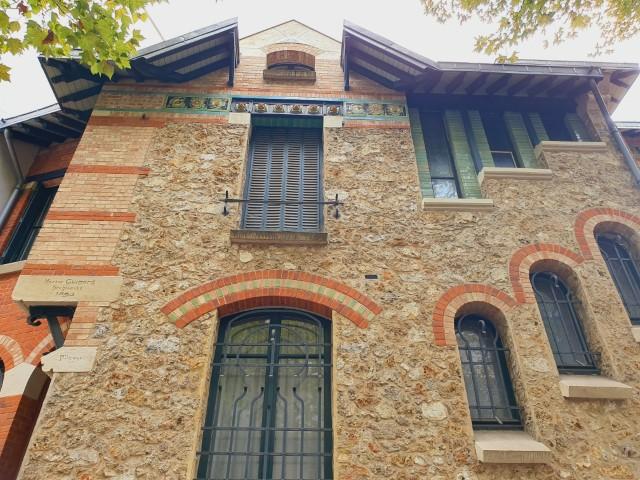
The last stop in this part of the tour is a bit farther away on 41 Rue Chardon Lagache.
Hôtel Jassedé is also a Guimard building, but you may not notice that right away.
This residential home from 1893 was one of his first works.
It is not a typical Art Nouveau building, though it already has some of the characteristics indicative of the architect’s future style, like the asymmetrical facade.
One of the remarkable things about this building is the liberty that the architect had in playing with various materials, including carved stone, ceramics and bricks.
This freedom is a sign of the post-Haussmann era, when Parisian facades no longer had to maintain a uniform appearance.
Right next to Hôtel Jassedé, you can see Villa de la Reunion, a private home with a more typical Art Nouveau design, also by Guimard.
Paris art nouveau guided tours
To see more Parisian Art Nouveau, you can take a guided tour with a professional guide. Here are some options:
Art Nouveau and Art Deco tour – This small group tour covers the 8th and 9th arrondissements near the opera.
Paris Art Nouveau Walking Tour – This is a good option if your prefer a private tour.
Other great places to see Art Nouveau in Europe
More Paris travel guides and tours
Save this guide to Art Nouveau architecture in Paris on pinterest


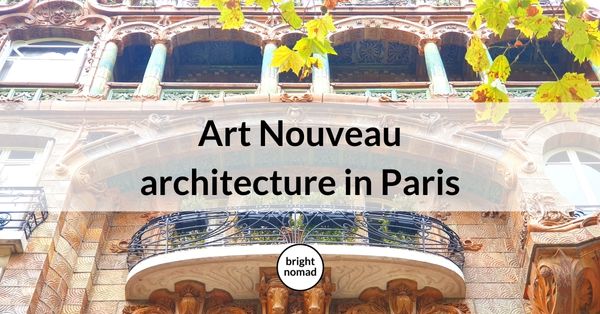
1 Comment
Awesome info in this blog. Thanks for sharing this.